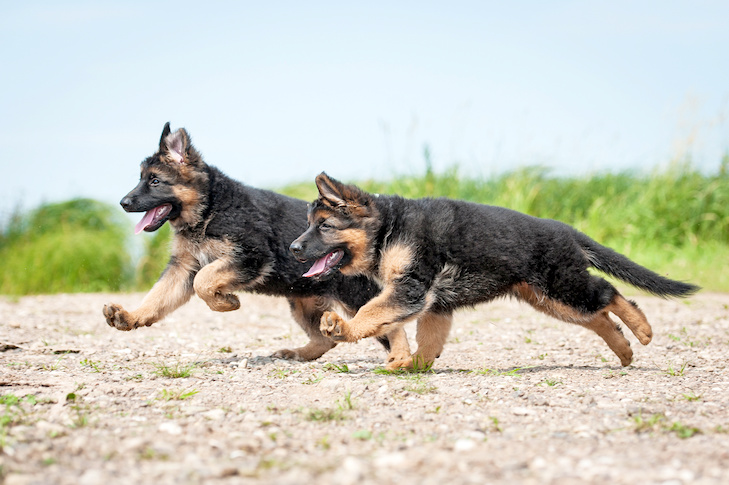When a new puppy arrives, you’re likely to be focused on helping them feel at home with your family rather than any health concerns the dog may have. But a growing puppy can be at risk for developmental disorders such as panosteitis, which can be very painful.
Fortunately, by knowing the risk factors and early signs of growth-based health concerns such as panosteitis, you can take simple steps to prevent the condition and keep your growing puppy healthy.
What Is Panosteitis?
Panosteitis is a painful developmental disorder that occurs in young, rapidly growing, large-breed puppies. Affected puppies may experience waxing and waning musculoskeletal pain, not unlike growing pains in humans. The exact cause of panosteitis is unknown, but researchers have theorized that excessive dietary protein intake may be partly to blame. The disease likely also has a hereditary component, as some breeds are much more commonly affected than others.
Risk Factors for Panosteitis in Puppies
Any large or giant breed puppy can develop panosteitis, but German Shepherd Dogs make up the vast majority of cases. Other highly susceptible breeds include:
- Basset Hound
- Golden Retriever
- Great Dane
- Labrador Retriever
- Rottweiler
- Saint Bernard
- Doberman Pinscher
Panosteitis also occurs more commonly in males than in females. Young dogs between 5–18 months of age are most commonly affected, but rare cases have been reported in middle-aged dogs as well. Once a dog develops panosteitis, episodes of pain and lameness may continue intermittently until the dog is 1–2 years old. Flare-ups occasionally also occur in adult dogs, sometimes referred to as “recycling” of panosteitis.

Symptoms of Panosteitis in Puppies
Panosteitis symptoms may come and go for several weeks at a time and can include:
- Sudden-onset lameness in one or more limbs
- Lameness that shifts between limbs
- Severe pain, especially when the affected limbs are palpated
- Unwillingness to rise
- Loss of appetite
- Excessive vocalization
- Fever
Treatment of Panosteitis in Puppies
There is no cure for panosteitis and treatment is focused on relieving pain while the disease runs its course. Your veterinarian may recommend starting your dog on a non-steroidal anti-inflammatory drug (NSAID) to decrease pain and inflammation during flare-ups of panosteitis. Some dogs respond better to one NSAID over another, so it may take some trial and error to find the right medication. Your pup should also rest and avoid strenuous activity during these episodes.
You may also need to transition your dog to a new diet to help prevent further problems. Your veterinarian can help you choose the best diet for your puppy’s age and breed. If your puppy is overweight, developing a gradual weight-loss plan with your veterinarian’s guidance can reduce the stress on the painful limbs and prevent future orthopedic issues.
While it’s heartbreaking to see your puppy in pain, the good news is that most cases of panosteitis will eventually resolve on their own. Some resolve in as little as two or three weeks, while others may continue to experience intermittent flare-ups until the puppy reaches skeletal maturity.

Preventing Panosteitis and Other Growth-Based Health Concerns in Puppies
Preventing panosteitis is difficult because no single inciting cause has been identified, but you can help protect your pup by focusing on its health.
Diet
The best way to keep your puppy healthy is to feed a breed-appropriate, commercially made dog food specifically formulated for puppies. A complete and balanced puppy diet should provide sufficient protein and correct calcium and phosphorous balance to prevent growth disorders. Portions must be carefully controlled to provide adequate caloric intake while preventing excessively rapid growth. Treats should also be limited to no more than 10% of your puppy’s daily caloric intake to prevent obesity.
Exercise
Your puppy needs regular exercise for healthy growth and development, but too much exercise can also be a problem. In growing large- and giant-breed puppies, it is especially important to avoid high-impact activities, such as jumping and sustained running, which can put too much strain on their developing bones and joints. A good rule of thumb is that a puppy should not participate in any activity beyond what they would normally engage in with other puppies of the same age. For example, a six-month-old puppy will run in short bursts when playing with other six-month-old puppies, but should not be expected to accompany an owner on a sustained run.
Growth Rate
It is also important to note that puppies of different breeds will grow and mature at different rates. Skeletal maturity — the point at which the growth plates close and a puppy’s musculoskeletal development is complete — may occur at as early as 8 months for small breed dogs, while large and giant breed dogs may not fully mature until 18–24 months. It is important to know the rate at which your puppy’s breed matures so that you can make informed decisions regarding your puppy’s health.
Panosteitis is a painful condition for your puppy, but by taking each of these steps and focusing on your dog’s health, you can help minimize or even prevent it.
This article is intended solely as general guidance, and does not constitute health or other professional advice. Individual situations and applicable laws vary by jurisdiction, and you are encouraged to obtain appropriate advice from qualified professionals in the applicable jurisdictions. We make no representations or warranties concerning any course of action taken by any person following or otherwise using the information offered or provided in this article, including any such information associated with and provided in connection with third-party products, and we will not be liable for any direct, indirect, consequential, special, exemplary or other damages that may result, including but not limited to economic loss, injury, illness or death.

